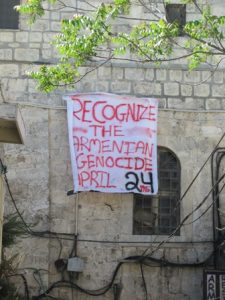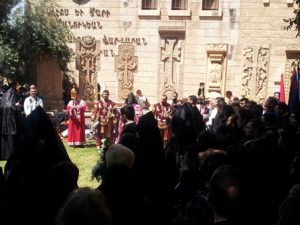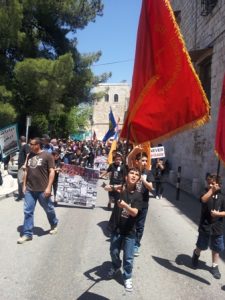April 24th is the day that was chosen to commemorate the Armenian genocide. On this date in 1915 two hundred and fifty of the Armenian leaders and intellectuals who lived in Istanbul and around it were arrested. The prisoners were taken to a locked facility near Ankara. Three days later the Othman parliament inspired by Mehmet Talaat Pasha, a member of the Othman triumvirate, accepted the Tehcir law known officially as “Sevk ve İskân Kanunu” – The law of shipping and resettling that allowed for the mass-deportation of Armenians from their towns and villages all over Anatolia during World War I. The Armenians were deported towards the Syrian Desert to the city of Dayr al-Zawr while subjected to horrifying cruelties and massacre. No one is sure as to the number of people murdered. Some say there were 600,000 dead others say there were one and a half million who died. Most of the researchers tend to verify the larger numbers.
98 years have past since these terrible days and every year the Armenian people all over the world assemble on this date to commemorate the events and remind the world of their people almost forgotten tragedy. The 2300 Armenians in Jerusalem are no exception. This year I joined the ceremony in Jerusalem. As I entered the Armenian quarter in the old city of Jerusalem I encountered a huge sign that demands recognition of the Armenian genocide. The Turkish government denies the events and claim the whole story is about a group of traitors who decided to cross the lines to the Russian side during war time and some were punished for that. The Turkish claim there was no genocide but a reasonable reaction in war time. The number of victims officially recognized by the Turkish is a lot smaller. Actually, only 25 states officially recognized the Armenian genocide.
When I got to the old church of St. James I was handed a document published by the Armenian “United Memorial committee”. As I was reading the document I got a clearer idea about the Armenian demands. “Turkey and the Turkish academia” so says the printed text that was later today sent to the Turkish consulate in Sheikh Jarrah neighborhood in Jerusalem, “poured millions to come up with a refined system of alibis, rationalizations all of them while distorting and denying what happened”. The text goes on and asserts that “In any attempt to destroy an entire people and culture, there are no two narratives. The international community has little patience with denial and demands modern Turkey to admit its historic crime”. The document end with a written hope that coming the 100th year of this tragic anniversary the Turkish government will admit to the facts and by doing so will correct some of the injustice it caused. I have to say I am not that optimistic about the Turkish government changing its narrative especially when I remember what happened when Turkish novelist Orhan Pamuk, recipient of the 2006 Nobel prize in Literature, decided to recognize the Armenian genocide in an interview he has given to a Swiss newspaper in 2005. This interview led to the legislation of a law that makes the insult of the Turkish identity a crime punishable by law. Pamuk himself barely escaped imprisonment.
The Armenians are known to be the first nation that accepted Christianity. They did that at 301 A.D. and they have solid proof of living in Jerusalem continuously from the 4th century till today. Good evidence can be found in the amazing bird mosaic dating to the byzantine era. The Mosaic was discovered near the Damascus gate. Another proof is a latter that was given to the Armenian community on the 7th century A.D. by the Muslim conqueror of Jerusalem – Omar. The church of St. James is according to tradition the resting place of James – the first bishop of Jerusalem and the half brother of Jesus Christ and of James the greater brother of John the Apostle who’s head is buried in St. James in Jerusalem and the rest of his body is in the cathedral of Santiago de Compostela. The church was built in the time of the crusades on top of older buildings and was rennovated in the 18th century thanks to a lot of money raised by Patriarch Gregarious. As the community of Jerusalem was very poor Gregarious decided to go on a fund raising church tour in Armenia. He put on a heavy metal chain while visiting the churches and was so successful that the money allowed him to pay the debts of the community, renovate the church and build a stone wall around the Armenian quarter in the old city of Jerusalem.
St. James was the location for the first part of the memorial services. It was not my first or second time in the church. I am quite used to taking groups there during almost every tour in Jerusalem. The place is opened for visitors only between 3:00 and 3:30 P.M. and a short ceremony is held in that time. I am used to seeing there about 20 or 30 people. Today I was surprised. Hundreds of people were standing in the main hall of the church. They were holding candles and listening to a liturgy special for this sad day. The crowd varied from religious figures and residents of the Armenian quarter to hundreds of Israelis members of youth organization such as Hashomer Hatzair and Hanoar Haoved who came to protest against the fact that the state of Israel will not recognize officially the Armenian genocide. I believe most of the Israelis standing in St. James church visit the place for the first time in their life.
The presence of those Non-Armenians was even more obvious outside the church. The square gave the day a feeling of a day of protest. The place filled with demonstrators singing songs of protest, holding the Armenian flag and signs condemning Turkey and demanding recognition. Some went further and made some territorial claims “Mount Ararat is Armenian!” said some signs. Mount Ararat is of a unique importance for the Armenians because of the part it played in the biblical story of Noah’s Ark. The Armenian priests head cover is shaped after Mount Ararat.
After the ceremony at St. James church another ceremony was held in the garden opposite the entrance to the Armenian quarter. There, under the Khatchkars (Stone curved crucifixes) the ceremony focused on the memories and presenting flowers. In past years the ceremony would then go to the Armenian cemetery in Mt. Zion but this year the Armenians decided to change their custom and held a secular political rally that ended not in the cemetery but in Mt. Zion near the buses that took the protestors to the Turkish consulate.
I decided not to join the protestors near the Turkish consulate and made my way back home while remembering a book: “The Forty days of Musa Dagh”. The books describes the events of the Armenian genocide from the perspective of a small village near Antakya where Gabriel Bagardian succeeded in rescuing his people. This fiction book was written in 1933 by the Jewish-Austrian writer Franz Werfel. A memorable dialogue from this book is held between a German pastor Johannes Lepsius and the Othman ruler Enver Pasha. The pastor says then: “If my leaders would treat people of my country who are of another race or hold different faith unjustly or in an inhumane manner I will leave Germany at that moment and go to America!”. Enver Pasha reacts to that saying ” Germany is doomed if there many who share your views! It will mean that your people lack the capability to fulfill its national intentions without mercy”.
Only six years separate the writing of this book and World War II who brought the Holocaust with it. Only six years. The affinity between the fate of the Armenian people and the fate of the Jewish people was so clear and strong today in the streets of the Armenian quarter of the old cit of Jerusalem and I couldn’t stop wandering about the state of Israel not recognizing the Armenian genocide.
A short film I took during The political rally
Some more pictures I took on that day


